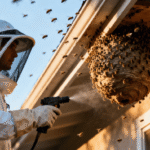Last Updated on July 30, 2025 by Muhammad Binyameen
Table of Contents
Key Takeaways:
Tree fertilization plays a critical role in supporting tree health and vigor, making them better equipped to resist diseases. By providing essential nutrients, fertilization strengthens trees’ natural defense mechanisms. This process can be tailored through scientific understanding to meet specific needs, enhancing the overall vitality of urban forests and landscapes.
Introduction
Trees, with their towering presence and verdant canopies, offer much more than aesthetic beauty. They are vital components of our environment, contributing to clean air, shade, and ecosystem diversity. One less often discussed aspect of tree health is their ability to resist diseases. This capability depends significantly on the nutritional status of the tree, which can be enhanced through expert tree services in Long Island, NY. In this article, we explore how tree fertilization bolsters disease resistance, aiding in preserving healthy, vibrant trees in our natural and urban landscapes. This understanding is crucial for anyone involved in tree care, from homeowners to arborists and urban planners.
Understanding Tree Fertilization
Tree fertilization is applying nutrients to trees to enhance their growth, health, and resilience against environmental stresses. The goal of fertilization is to supplement the available nutrients in the soil, ensuring trees have the necessary resources to thrive. Fertilization practices can vary widely depending on the tree species, the specific conditions of the environment, and the particular nutrient needs identified through soil and tissue testing.
In urban areas, where trees often contend with compacted soils, pollution, and competition with infrastructure, fertilization support becomes even more critical. Implementing strategies such as tree fertilization Fort Worth can be particularly beneficial, as targeted nutrient applications help maintain tree vigor amidst these challenging conditions.
The Role of Nutrients in Tree Health
Every tree relies on a balance of nutrients to maintain its physiological processes. These nutrients are fundamental to trees’ life support systems, influencing everything from growth and reproduction to defense mechanisms against pests and diseases. Like any living organism, trees require a mix of nitrogen, phosphorus, potassium, and micronutrients, including iron, manganese, and zinc. Together, these nutrients support vital functions, including photosynthesis, cell division, and the production of defensive compounds.
Read More: Revolutionizing the Insurance Landscape: How the B2B2C Model is Shaping the Future of Insurance
Trees can become stressed or weakened without adequate nutrition, making them more susceptible to diseases. Several biotic stressors, including fungi, bacteria, and viruses, can benefit nutritionally deficient trees, leading to decline and even death. Conversely, a well-nourished tree can better withstand these stressors thanks to robust structural integrity and a heightened ability to produce protective compounds.
How Fertilization Enhances Disease Resistance?
The interplay between nutrients and disease resistance is a complex but fascinating subject. When trees receive adequate nutrition, they have the energy and resources to initiate and maintain their defense mechanisms. For instance, well-fertilized trees can ramp up the production of phytoalexins and other defensive compounds, which act as a biochemical barrier against pathogens.
These nutrients also contribute to physical defenses. Calcium, for example, is crucial for building cell walls. Stronger cell walls mean there is a reduced chance of pathogen intrusion. Additionally, potassium plays a role in maintaining turgor pressure within the cell, which helps prevent the spread of infections. Regular and balanced fertilization ensures that trees can strengthen these defenses continuously.
Specific Nutrients That Aid in Disease Resistance
The relationship between nutrients and disease resistance can vary depending on the specific pathogen and tree species affected. However, several nutrients are broadly recognized for their role in bolstering trees’ defenses:
Nitrogen (N): While essential for growth, excess nitrogen can make trees more susceptible to certain diseases, as it may promote tender, new growth prone to pathogen attacks. However, when balanced, nitrogen supports overall health and vigor, which is foundational for disease resistance.
Phosphorus (P): Vital for energy transfer and storage, phosphorus helps in root development and flowering. A robust root system supports the tree’s ability to take up water and nutrients, indirectly contributing to its disease resistance.
Potassium (K): Known for regulating water use, potassium helps maintain cell turgidity and activates enzymes involved in growth and stress resistance. It also enhances disease resistance by contributing to a robust cell structure and overall health.
Calcium (Ca): Crucial for developing strong cell walls, a primary defense against infections. Calcium improves the structural integrity of plants and aids in cellular signaling related to defense responses.
Magnesium (Mg): Essential for chlorophyll production, magnesium plays a crucial role in photosynthesis and ensures adequate energy supply for all physiological activities, including defenses against pathogens.
The Importance of Timing and Application Techniques
Timing and application techniques are critical components of effective fertilization strategies. To maximize the benefits of fertilization, applying the correct nutrients at the right time and using appropriate methods is essential. For example, fertilization during the active growing season typically yields the best results, as trees can readily absorb and utilize the nutrients.
Application methods vary, and the choice largely depends on the specific context and desired outcomes. Standard methods include surface application, subsurface injection, and foliar sprays. Surface application is straightforward and often used in broader landscapes, while subsurface injection can deliver nutrients directly to the root zone of urban trees, mitigating leaching and maximizing efficiency. Foliar sprays provide rapid nutrient uptake through the leaves and can be particularly useful in addressing micronutrient deficiencies.
Conclusion
Tree fertilization is essential for supporting trees’ health and vitality, enabling them to resist disease more effectively. By understanding the roles of various nutrients in plant physiology and maintaining balanced fertilization regimes, tree care practitioners can significantly bolster trees’ capacities to ward off diseases. These principles are vital for individual trees and contribute to the broader health of ecosystems, whether in a dense urban environment or a sprawling natural landscape. Although fertilization alone is not a silver bullet for disease prevention, it is a foundational component that ensures trees remain resilient and vibrant parts of our environment when integrated with proper care practices.
Apart from that, if you are interested to know about “Understanding Life Insurance for Company Directors” then visit our “Daily Bites” category.



























